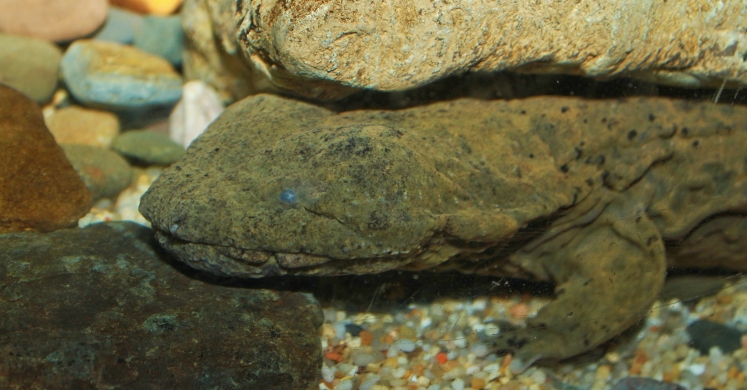Blog

#bioPGH: Meet Pennsylvania’s State Amphibian!
 A resource of Biophilia: Pittsburgh, #bioPGH is a weekly blog and social media series that aims to encourage both children and adults to reconnect with nature and enjoy what each of our distinctive seasons has to offer.
A resource of Biophilia: Pittsburgh, #bioPGH is a weekly blog and social media series that aims to encourage both children and adults to reconnect with nature and enjoy what each of our distinctive seasons has to offer.
It’s official! As of this past Tuesday, Pennsylvania has a state amphibian: the hellbender. Despite their ominous name, and their even wilder nicknames (snot otter, lasagna lizard, devil dog, Allegheny alligator, etc), hellbenders are harmless, albeit large, salamanders. Their primary defense mechanism against humans and other predators is the production of a thick slime in addition to their existing mucus coating, which ultimately makes them difficult to grasp or hold on to—hence the “snot otter” nickname. Hellbenders have long graced our state with their presence, but conservation concerns have brought them to wider attention and ultimately helped them reach their status as our state amphibian. Let’s learn more about our friend the “Allegheny alligator” shall we? (But just so we’re clear, hellbenders may be large, but they’re not reptiles!)
We have two subspecies of hellbender in North America, the Eastern hellbender salamander (Cryptobranchus alleganiensis alleganiensis) and the Ozark hellbender (Cryptobranchus alleganiensis bishopi). Reaching lengths of up to two feet long, hellbenders are the continent’s largest amphibians, and they are closely related to the world’s largest amphibian, the Giant Chinese Salamander (Andrias davidianus), which has been documented well over five feet long!
Unlike most other amphibians, hellbenders are entirely aquatic throughout their life spans. Though they do have lungs that are somewhat functional, as adults hellbenders primarily "breathe" through their skin, which is permeable to oxygen. In fact, their skin is so wrinkly to increase surface area and allow more oxygen absorption underwater (those wrinkles are the inspiration behind "lasagna lizard"). This adaptation works well for them, and hellbenders spend most of their time under large flat rocks in quick-moving streams where they prey primarily on crayfish but also fish, and even on occasion other hellbenders and snakes!
Outside of their daily activity, hellbenders play an important role for us humans: they serve as an indicator species. Hellbenders need high quality streams to survive, thus, they “indicate” to us through their presence or absence whether or not a particular stream is healthy or polluted. Unfortunately, hellbenders have been in decline since the 1980’s. Possible reasons behind this include water quality issues, disease, and habitat degradation. Many states have responded by listing hellbenders as state endangered, but since hellbenders don’t breed until they are 3-6 years old (depending on where they live), population recovery is a slow challenge. If you are interested in getting involved in hellbender conservation, check out what the Western Pennsylvania Conservancy and the Chesapeake Bay Foundation have been working on to support the species.
In closing, just case you are still wondering how the hellbender earned such a variety of nicknames, I will leave you with this. If a picture of a hellbender is worth a thousand crayfish, then a video must be worth a river!
Connecting the Outdoors Tip: If you would like to see a hellbender in the wild, keep your eye on the PA DCNR's calendar of events page. They periodically hold "Hellbender Hunts" in the state parks, and you can ask your guide any hellbender questions that you might have. (It's best to go with a trained naturalist since the habitat types that hellbenders prefer are sensitive.)
Continue the Conversation: Share your nature discoveries with our community by posting to Twitter and Instagram with hashtag #bioPGH, and R.S.V.P. to attend our next Biophilia: Pittsburgh meeting.
Resources
Fish and Wildlife Service: Eastern Hellbender
National Geographic: U.S. Giant Salamanders Slipping Away: Inside the Fight to Save the Hellbender
NPR: Snot Otter Emerges Victorious In Vote For Pennsylvania's Official Amphibian
Eastern Hellbender Status Assessment Report
Photo credits: Cover, Wikimedia User Brian Gatwick, CC-BY-2.0; Header, Pexels CC0

